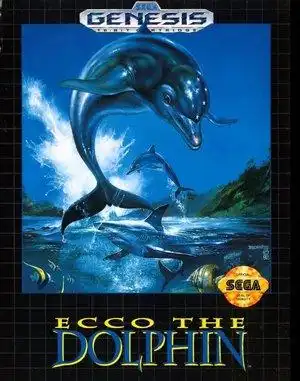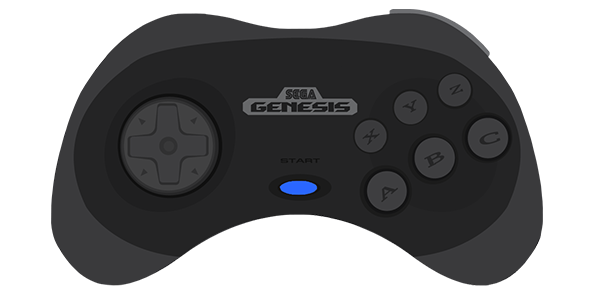Ecco The Dolphin: Diving Back into Sega's Aquatic Enigma
Few games from the 16-bit era conjure up such a specific mix of serene beauty and white-knuckle frustration quite like Ecco The Dolphin. Released by Sega Genesis in 1992, this action-adventure title wasn't your typical platformer or beat 'em up. Instead, it plunged players into a vast, mysterious underwater world, tasking them with guiding a lone dolphin through incredible challenges.
It was a game that looked stunning, sounded hauntingly unique, and possessed a story that quickly spiraled into the truly bizarre. For many of us who grew up with a Sega Genesis (or Mega Drive!), Ecco was an unforgettable, if sometimes infuriating, experience.
Diving Back In: What Made Ecco Unique?
Forget spiked turtles and bouncing mushrooms. Ecco The Dolphin offered a fundamentally different kind of world. The environments were breathtakingly detailed for the time – vibrant coral reefs, dark, eerie caves, and later, truly alien landscapes. The soundtrack, inspired in part by Pink Floyd, was ambient and atmospheric, perfectly complementing the feeling of exploration and isolation.
But it wasn't just the presentation. Playing as a dolphin felt genuinely unique. You weren't running and jumping; you were swimming, breaching, and using sonar. It was a bold departure from the norm, creating a sense of wonder and discovery that few games attempted.
The Gameplay Loop: More Than Just Swimming
At its core, Ecco's gameplay revolved around movement, communication, and survival.
- Swimming & Ramming: Ecco could swim at varying speeds, building momentum for a powerful ramming attack used to fend off predators or break objects.
- Song & Echolocation: Ecco's signature ability was his song. A short tap could communicate with other marine life or interact with objects like guiding glyphs. Holding the button activated echolocation, providing a crucial map of the surrounding area.
- Air and Health: As a mammal, Ecco needed air, either from surfacing or finding air vents. Managing the air meter was a constant tension, adding urgency to exploration. Health, depleted by enemies or lack of air, was restored by eating fish or interacting with special glyphs.
- Glyphs: These ancient crystals were key to progression, often requiring Ecco's song to activate, providing information, unlocking paths, or granting power-ups.
This blend of mechanics created a puzzle-like exploration experience, often requiring careful observation and clever use of Ecco's abilities to progress.
The Story: A Dolphin's Epic Journey
Ecco's journey begins innocently enough. While playing with his pod, a sudden, colossal storm appears and sucks every living creature out of the water – except for Ecco. Alone and determined, he sets off to find his missing family.
What follows is anything but simple. Ecco's quest leads him to seek wisdom from ancient beings like the 'Big Blue' whale and the 'Asterite'. He discovers the lost city of Atlantis and learns of an alien race called the Vortex, who periodically harvest Earth's oceans for food. This revelation sends Ecco on a mind-bending time-travel adventure, journeying millions of years into the past to gain the power needed to confront the Vortex Queen and rescue his pod. It's a surprisingly deep and wonderfully weird narrative for a 90s console game about a dolphin.
Was Ecco The Dolphin That Hard?
Yes. Yes, it was.
While the atmosphere was calming, the difficulty was anything but. Ecco is notorious for its challenge. Why?
- Vague Guidance: The game often gave minimal hints on where to go or what to do next, leading to frustrating trial-and-error exploration.
- Environmental Hazards: Beyond enemies, currents, crushing walls, and the ever-present need for air made navigating levels perilous.
- Tricky Combat: Ramming required precise timing and positioning, and getting hit often meant significant health loss.
- Late-Game Spikes: The final levels, particularly those involving the Vortex and time travel, ramped up the difficulty significantly. Ed Annunziata, the game's creator, even admitted to deliberately making it difficult to prevent players from finishing it too quickly via rentals!
This difficulty was a major talking point back in the day and remains a core part of Ecco's legacy.
Playing Ecco Today: Where to Find This Classic
Fortunately, you don't need to dust off your old Sega Genesis to experience Ecco The Dolphin. This classic has seen several re-releases over the years:
- Steam: The original Genesis version is available for purchase on Steam.
- Nintendo Switch Online + Expansion Pack: Subscribers can play the Genesis version as part of the retro game library.
- Other Compilations: Ecco has appeared on various Sega Genesis/Mega Drive collections for platforms like PlayStation, Xbox, and PC over the years.
- Emulation: As with many retro games, emulation via programs like Kega Fusion or online emulators is another popular way to play, though legality varies depending on how you acquire the ROMs.
Experiencing Ecco again (or for the first time) is a trip. It's a reminder of a time when game design was perhaps more experimental, willing to trade mainstream accessibility for a unique vision.
Why Ecco Still Resonates
Ecco The Dolphin wasn't just a game; it was an experience. It challenged players with its difficulty, captivated them with its world, and intrigued them with its bizarre, epic story. It stands out as a truly memorable title from the 16-bit era, a testament to Sega's willingness to push boundaries and create something truly different. Whether you conquered the Vortex back in the 90s or are curious to dive in now, Ecco's underwater world still holds a strange, beautiful, and challenging magic.
FAQ
Q: What kind of game is Ecco The Dolphin? A: Ecco The Dolphin is primarily


